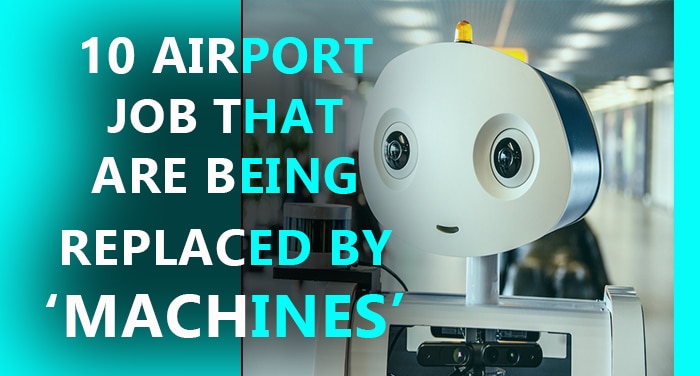Aerospace
10 Airport Job that are being replaced by Machines in 2018-19

Top 10 Jobs that are being replaced by Machines. The development already begun in many top airports across the world like.
LG Robot :
The robot will be able to speak English, Korean, Chinese, and Japanese by the end of the month. It can tell passengers the weather in their final destination, information about flights or display a map of the airport. When it speaks, Troika’s screen shows eyes that blink and smile. Another state-owned airport operator, Korea Airports Corp, which operates 15 international airports in South Korea but not Incheon airport, has teamed up with local companies to introduce air-purifying robots to measure air quality and clean terminals.
https://www.youtube.com/watch?v=SoEvzmSbQOI
Watch Direct on YouTube : Click here
KLM Spencer:
During the various tests Spencer scanned boarding passes from passengers and guided them to the correct departure gate. Spencer heads off automatically and the passengers follow the robot, which adjusts its speed to that of the group, avoiding obstacles and informing passengers of the remaining distance to their departure gate. When they get there, Spencer reports this via a screen. The first virtual border tunnel will be installed in Dubai International Airport by the end of next summer and additional tunnels will be added throughout the airport’s terminals by 2020. The tunnels will initially conduct face scans, with iris scanning capabilities being added later on.
CLEAR technology :
Clear doesn’t replace any actual security measures, but it does replace the identification process during check in. Clear allows passengers to bypass the process of waiting on a representative to check IDs and boarding passes, instead simply scanning their finger or iris. After verifying members’ identities with a tap of a finger or blink of the eye, Clear members can proceed directly to bag scans and metal detectors. Clear has already been certified as a “qualified anti-terrorism technology” by the U.S.

Aerospace
Boeing Transfers Rocket Stage to NASA, Paving Way for Human Moon Mission

Boeing has achieved a significant milestone by providing NASA with the second core stage of the Space Launch System (SLS) rocket.
This crucial component, crafted at NASA’s Michoud Assembly Facility (MAF), is set to propel the Artemis II crew into lunar orbit, marking humanity’s return to deep space after a 50-year hiatus.
The monumental Boeing-built rocket stage, the largest element of the Artemis II mission, will embark on a journey aboard the Pegasus barge, traveling 900 miles to NASA’s Kennedy Space Center.
Comparison of two legendary aircraft B777x vs B747 aircraft:Click here
Upon arrival, it will be meticulously integrated with other essential Artemis II components, including the upper stage, solid rocket boosters, and NASA’s Orion spacecraft within the iconic Vehicle Assembly Building. This intricate integration process is a vital step toward the eagerly anticipated Artemis II launch, slated for 2025.
“Boeing-built products helped land humankind on the moon in 1969, and we’re proud to continue that legacy through the Artemis generation,” remarked Dave Dutcher, vice president and program manager for Boeing’s SLS program. “Together, with NASA and our industry partners and suppliers, we are building the world’s most capable rocket and paving the way to deep space through America’s rocket factory in New Orleans.”
NASA, Lockheed Martin Reveal X-59 Quiet Supersonic Aircraft:Click here
The delivery of Core Stage 2 marks a significant achievement in the evolution of the SLS rocket. Towering over 200 feet and powered by four RS-25 engines, this core stage, coupled with two solid-fueled booster rockets, will generate a staggering 8.8 million pounds of thrust. This immense power is crucial to launching Artemis II and future missions into the vast expanse of space.
The SLS rocket stands unparalleled in its capability to transport both crew and substantial cargo to the moon and beyond in a single launch. Its extraordinary capacity will facilitate the delivery of human-rated spacecraft, habitats, and scientific missions to destinations including the moon and Mars, ushering in a new era of space exploration.
-

 Travel1 week ago
Travel1 week agoAir India to Expand US Operations with Three New Routes After a Decade
-

 Travel2 weeks ago
Travel2 weeks agoWhy We Should Avoid These Stamps in a Passport
-

 Airlines1 month ago
Airlines1 month agoInvestigations Reveal Fake Chinese Titanium in Boeing and Airbus Jets
-

 Tech4 weeks ago
Tech4 weeks agoChina’s CATL Plans 1,800-Mile Electric Plane Launch by 2027
-

 Airport3 days ago
Airport3 days agoTop 10 Largest Airports in the World by Size
-

 Aerospace4 weeks ago
Aerospace4 weeks agoChina’s Fighter Jets Turn Wings into Autonomous Drones
-

 Airlines4 days ago
Airlines4 days agoAir India Rolls Out A350s for Delhi-New York JFK and Newark Routes
-

 Defence3 weeks ago
Defence3 weeks agoBoeing Enhances Chinook with New Engines and Block II Upgrades at $96 Million







